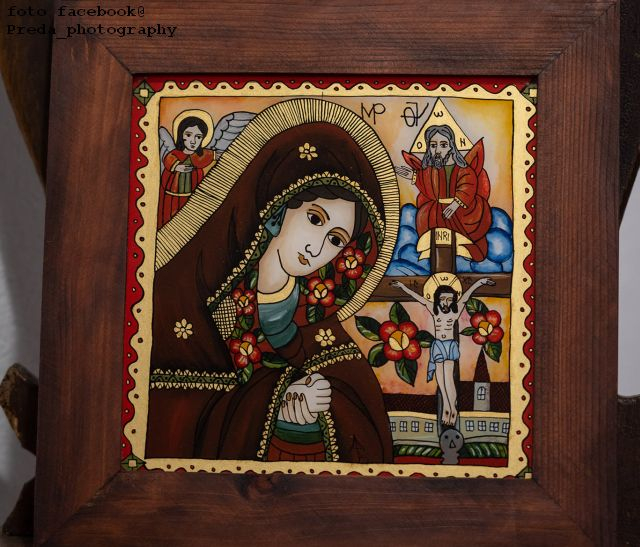The Museum of Icons on Glass in Sibiel
The village of Sibiel is a rural site of touristic and heritage interest.

Christine Leșcu, 08.10.2022, 14:00
Located 20 kilometers away from Sibiu, the village of Sibiel became in time a rural site of touristic and heritage interest. Traditionally inhabited by Romanians settled in the vicinity of the big city in southern Transylvania, in the area known as Mărginimea Sibiului, Sibiel is also home to the most important museum of icons on glass in Romania. Masterpieces of naive peasant art, as well as objects of worship, the icons on glass adorned the homes of people in most regions of Romania. And starting at the end of the 1960s, they started being collected by the priest Zosim Oancea to be exhibited in the museum he founded in the courtyard of the Holy Trinity church in Sibiel.
The current parish priest, Bogdan Flueraș, will next tells us about the biography of Father Zosim and about his creation: “This museum was built by father Zosim Oancea between 1976-1983, in full communist period. He came to Sibiel in 1964, after a period of 15 years of communist detention. In 1965 he rediscovered the painting from the Holy Trinity church in Sibiel and in 1969 he had this special idea to create a museum of icons on glass and thus laid the foundations of the first museum of icons, also in Sibiel, in a smaller building, which he finished in 1973.Then, because the building was too small to serve its purpose, Father Zosim manages to erect the current building. Father Zosim was not from the area of Mărginimea Sibiului. He was born in the village of Alma, also in Sibiu County, but near the city of Mediaș. He taught religion in a school in Sibiu and that’s how he ended up being imprisoned. Afterwards he became a priest in Sibiel where he died.
Along the years, the Sibiel museum gathered an impressive collection of over 600 icons on glass from all over the country, the oldest dating from the 18th century and the newest from the 19th century. The icons come from the village of Nicula, located in Cluj county, from Mărginimea Sibiului, from Bucovina and the north of Moldavia, from the areas of Brașov and Făgăraş, and also from the west of the country, from Banat.
Next, the parish priest Bogdan Flueraș will tell us how they got to Sibiel: “These icons belonged to the people of the village before they reached our museum. Father Zosim brought the icons from their houses. Some icons were purchased or donated, but most of them were brought from peoples homes. I could tell you the story of one of the icons in our museum. Father Zosim had a way with the people. He once went to the house of a faithful woman and saw there, on the wall, a special icon. Of course, he asked her to give the icon to the museum, because there it would have more visibility and many other people would be able to admire it. The woman was not very pleased with Father Zosim’s proposal, but still she made a promise to the father: if he managed to collect 99 icons, then her icon will be the hundredth. Of course, Father Zosim quickly collected 99 icons and the woman kept her word and gave the icon to the museum.
Most of these icons represent the Virgin Mary and Jesus Christ, as well as saints such as Saint George, considered the protector of spring, Saint Elijah, the protector of summer, Saint Nicholas, the patron of winter and Saint Demetrius, associated with the autumn season. Therefore, the icons on glass represent the peasant universe dominated by religious beliefs, and also by the concern for nature.
The paints and materials used to create the icons are also natural, as we have learnt from the parish priest Bodgan Flueraș: “The peasants used colors that they could find in their households, such as the egg yolk or egg white. The glass used for the icons is also different. At first, icons were painted on a very thin glass, which can be easily seen by visitors. Basically, these icons differ a lot in terms of colors and sizes. For example, the first painted icons were those from Cluj. They are small, have much more sober, much darker colors. But they are equally very beautiful. Then, there are the icons originating from the Sebeș and Alba Iulia area, which have a certain shade of green. The color blue predominates in Mărginimea Sibiului, as well as in the area of Brașov and Făgăraș. In Bucovina and in the north of Moldavia, the yellow color predominates, as well as the green color. We even have an icon, very beautiful, in which Jesus Christ the Savior is painted with a fur waistcoat from Suceva region. This shows that people not only worship and honor icons, but also adapt them to the folk traditions of their area. Thus, in the Cluj area, at Nicula, or in the Mureș Valley, we find that specific headscarf with which the iconographers or peasants adorned the Virgin Mary-Mother of Jesus in these icons. So, the icons can be differentiated according to these details.
Born in 1911, Father Zosim Oancea died in 2005, and the museum of icons on glass that he established in Sibiel contributed to the transformation of the village into a place of cultural and tourist interest. (LS)






























